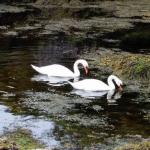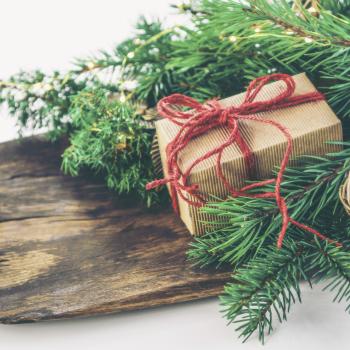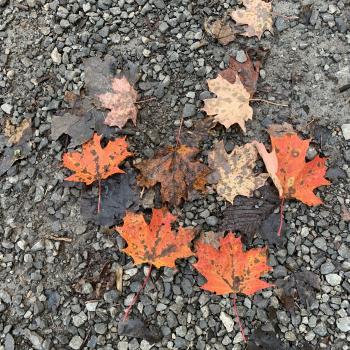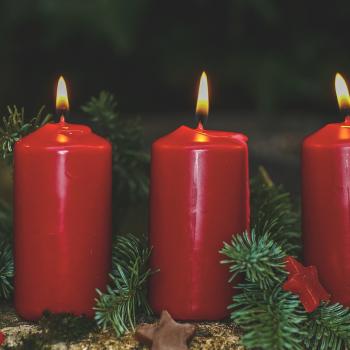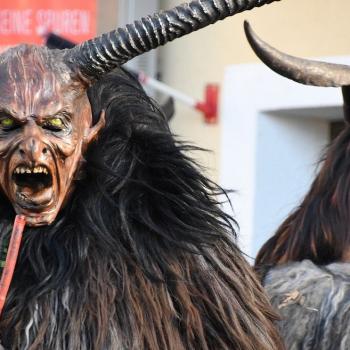Open the doors
Let us play
It’s cold in the snow
At Christmas.
Get away you old monkey
Your breath it stinks
Stop hooting and hollering
At Christmas
The mare is of the prettiest
Let us play
Her head is full of knots
At Christmas
Instead of you freezing
Well, lead the Mari
Inside to entertain us
Tonight
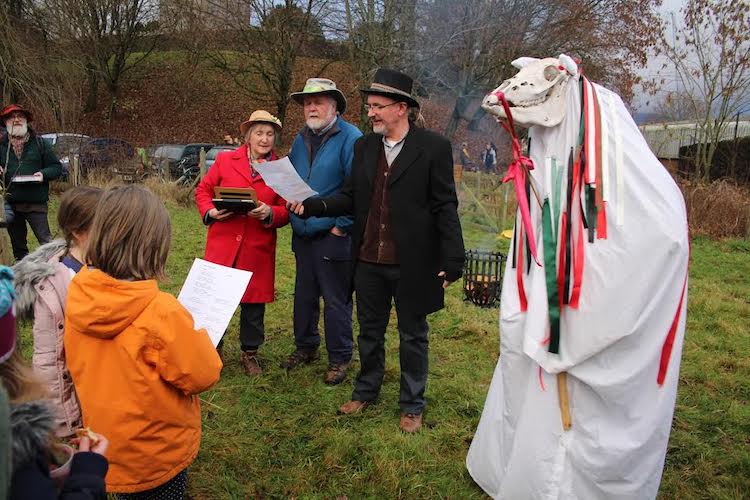
The Welsh Mari Lwyd is traditionally associated with the period from Christmas through New Year, Twelfth Night and Hen Galan (the Welsh Old New Year, based on the Julian calendar date). However, as I mentioned in Horses of the Dark Time, many believe that the Mari Lwyd may have originally been associated with Samhain, and more and more Maris are appearing at Samhain again. In working on this piece, I’ve also found Maris venturing forth as late as Imbolc. (Maybe it’s global warming.)
The Mari Lwyd is created by mounting a horse’s skull on a pole. The lower jaw is hinged and can be opened and closed by the operator, often called the rider, or simply the man under the sheet. The sheet is attached to the skull to cover the rider’s body. The Mari is decorated with ribbons, bells and other trinkets, and the eye sockets are filled in with the bottoms of glass bottles or something similar, and are often lit from within. The Mari party usually includes an Ostler, who leads the horse, a Punch and Judy (a she-male) who carries a broom, and some singers.
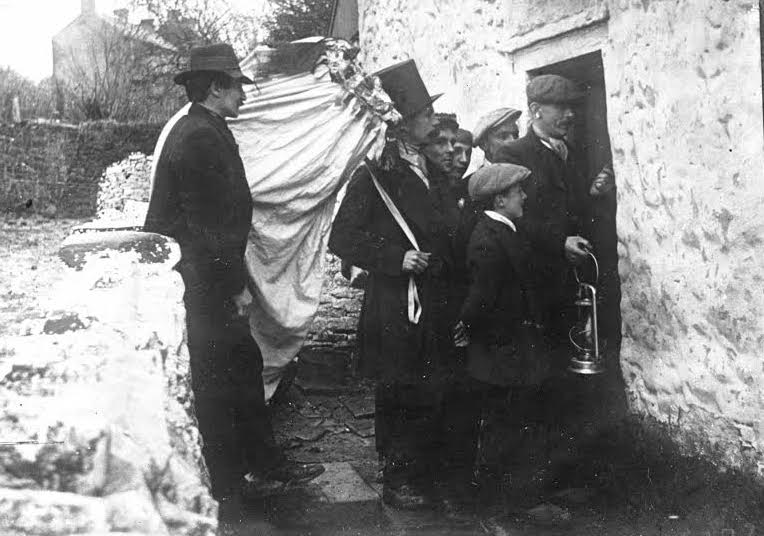
Traditionally, the Mari parties went from house to house, where a complicated exchange of verses were sung through the closed door, before the party was finally admitted. These verses, called the pwnco, were often improvised and very witty, and argued as to whether the Mari and her friends should be allowed into the house. When they did finally gain admittance, they usually caused a bit of havoc, chasing and frightening women and girls and sweeping the hearth ashes onto the floor. (This short video from the 1970s give of flavor of it.) However, things usually ended well, with music, food and drink, and a collection taken. I’ve written more about this tradition in Rambles with The Mari Lwyd.
Social change and the decline of the Welsh language after the First World War caused the tradition to shrink away to a few remnants, but with the folk revival of the mid-20th century and the advent of Welsh medium schools, things have improved. Local traditions have grown up again, with a few differences. They are a bit less spontaneous, they tend to visit pubs or public venues rather than private houses, and the pwnco is rarely improvised. Collections now usually benefit charities.
In the past few years, the Mari Lwyd tradition has taken on something of a cult status which has seen it begin to morph again, and move into new territory with modern Pagans, and people somewhere in that margin between Goths and almost-Pagans, taking an interest. Happily, the traditionalists, Pagans and the rest seem to be forming a relaxed coalition. There is a vibrant reinvention of folk traditions taking place in southwestern Britain against a background of Paganism and a thriving “alternative” scene.
There are now two big annual events framing the Mari season. Around Samhain the Museum of Witchcraft and Magic in Boscastle, Cornwall hosts the Dark Gathering, in which Border Morris dancing and the Mari Lwyds are central. Then in late January the Chepstow Wassail and Mari Lwyd takes place. Chepstow is right on the river Wye, which forms the Welsh-English border. Earlier in the day people gather on the English side to wassail local apple trees, while the Welsh have their own merrymaking. At night the two groups meet on the bridge over the Wye that separates the two countries, with lots of drumming and pageantry. This is followed by a Mari Lwyd ceremony in Chepstow and a dance.
Sue and John Exton are enthusiastically involved with these events, with their two horses, Mari Seren and Mari Celeste. The four of them feature in this beautiful new short video. John and Sue are both artists, and this shows in their approach to the Mari Lwyd tradition. John kindly agreed to share some of his thoughts about their motivation for what they do, and how they feel about their involvement in this changing tradition.
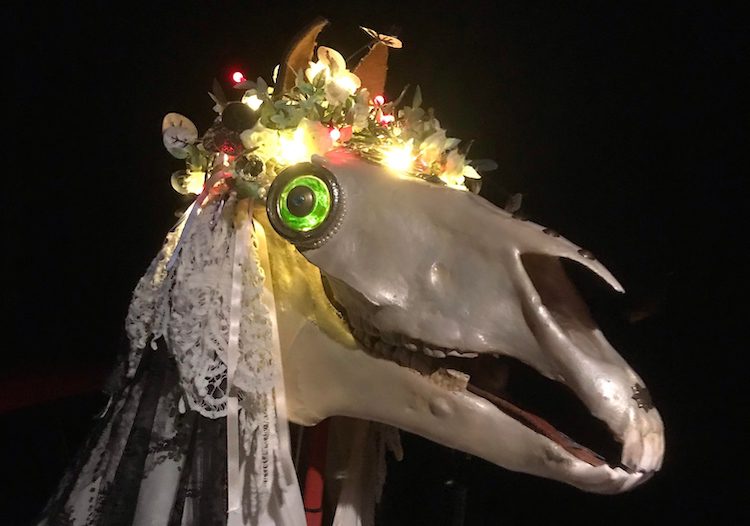
“We are not Pagans,” he explained. “We touch all religions and see our beliefs as a fusion of religions. Some see the Mari as a puppet and a performance work of art. We try to get into the mindset of the horse and let it speak to us…and move accordingly. When you dress and put on the skull and garments you assume the spirit of the horse.
“Traditionally the Maris are locked away in chests and suitcases after the festivities have ended in January. In the Gower peninsula the skull was buried in January and exhumed the following December, emphasising a rebirth or resurrection. Celeste and Seren are a part of the household and they remain on their stands throughout all the seasons. We talk to them, stroke them and they are bone sisters to my two daughters!
“At present the number of Mari Lwyds is reaching dizzy heights. People are looking for ways of expressing themselves, whether Pagan, traditionalists, folk groups, or solitary practitioners. The Mari although dead, is alive and well!”
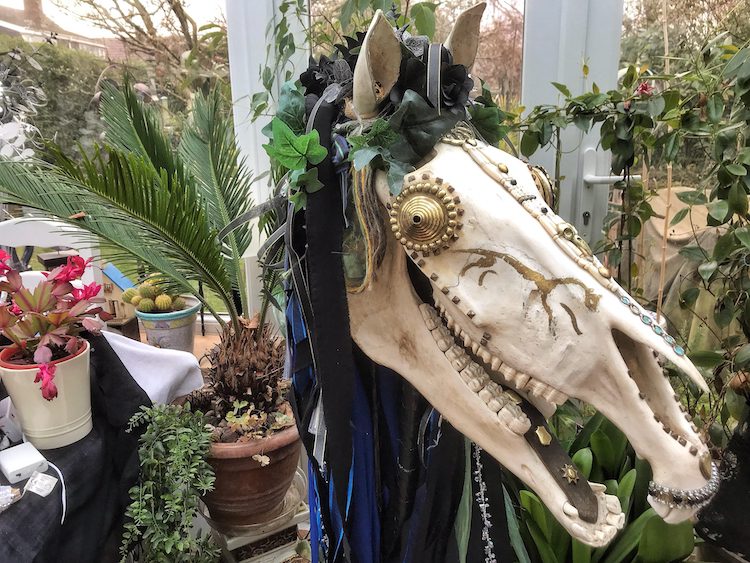
Less in the public eye, towns and villages also have their Maris, and I’ve been talking with Derwydd Newydd of Abergavenny about his involvement. The Abergavenny Mari makes her outing at Hen Galen (around January 13th) and appears again for an orchard wassailing at Imbolc. From a traditional Welsh background, and with a degree in Welsh and archaeology, Derwydd is keen to keep this tradition alive, like most people who are involved. His story is a little different than most, both because he considers carrying the skull part of his practice as a Pagan, and because of the circumstances in which he acquired his Mari.
“I’m an archaeologist in my day job. I was recording some Bronze Age burial cairns when I saw in the distance a “new” (i.e. previously unrecorded) cairn and set off to investigate. About halfway there, I literally tripped up over the skull. There were no other remains of the pony, just the skull, complete with jaw-bone (which is unusual as the jaw is generally missing). The skull was completely clean and had been there a long time as there was some moss growing on it. I had in the past tried unsuccessfully to make a Mari, but I took this as a gift.”
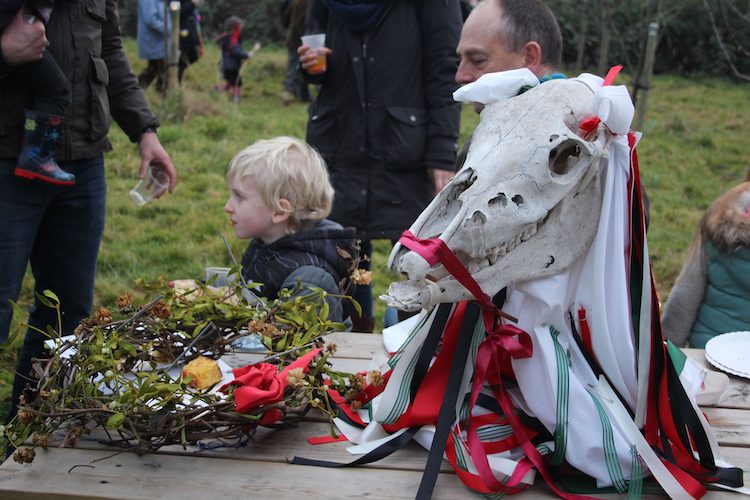
He describes being under the sheet like this. “Haven’t told anybody this but Epona-Rhiannon is very close and the spirit of the pony (the actual pony) is also close and kind of inhabits me. There, said it . . . I hesitate to utter “shamanic”! The room is electric every time she comes in. People are scared and drawn to her at the same time. It’s powerful magic – genuinely. I feel that the goddess’s presence and power is channelled through me and the pony at the same time – the pony and I meld into each other as the conduit for the magic of the goddess.”
—–
You can follow Kris at her blog Go Deeper and support her work on Patreon.




